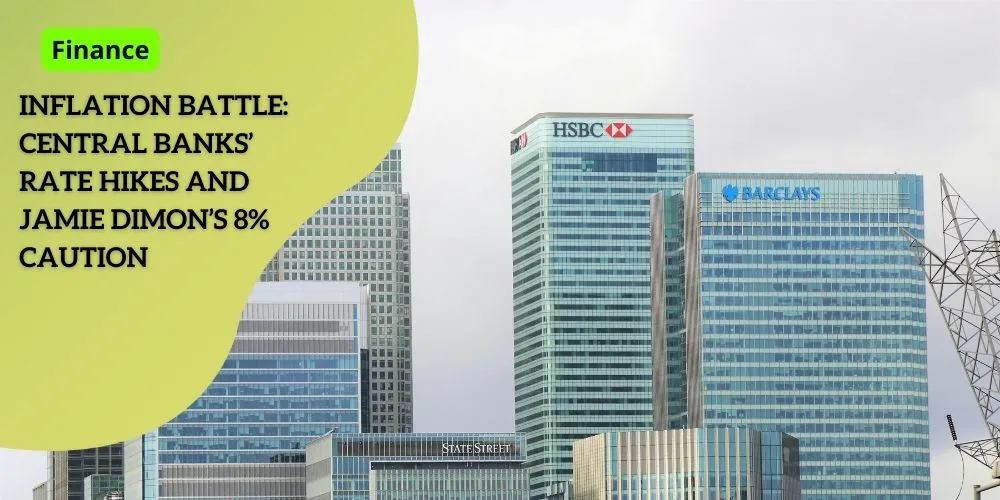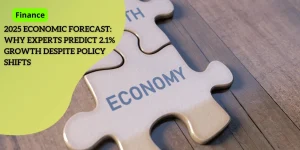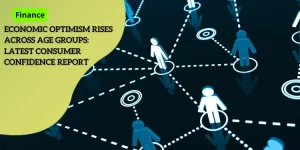Inflation Battle: Central Banks’ Rate Hikes and Jamie Dimon’s 8% Caution

Global Inflation Battle: Central Banks Raise Rates
Central Banks Step Up
Across the globe, central banks are ramping up interest rates in their ongoing effort to combat persistent inflation. This strategic move targets the high costs of goods and services impacting diverse sectors of various economies worldwide.
The Federal Reserve Joins the Effort
The Federal Reserve, America’s central bank, has also joined this global initiative. By raising interest rates, the Federal Reserve aims to cool off a heated economic climate characterized by rapidly increasing prices. Although this approach hopes to slow down inflation, it has a significant balancing act to perform.
A Tactical Approach
Higher borrowing costs serve as the main mechanism behind the Federal Reserve’s strategy. By making loans and credit more expensive, the central bank attempts to discourage excessive spending and borrowing. The overarching objective is to strike the right balance between curbing inflation and not overly stifling economic growth.
Impact on the US Economy
Despite the surge in interest rates, the US economy remains remarkably resilient. Specific sectors, such as housing, have experienced a noticeable slowdown due to elevated borrowing costs. However, the strong job market continues to demonstrate a robust performance, helping balance some of the economic strain caused by higher interest rates.
A Persistent Tug of War
While the slowdown in sectors like housing is a sign of the growing impact of increased interest rates, the resilience in the job market is a counteracting force. This juxtaposition creates a complex economic landscape, making policy decisions even more challenging for the Federal Reserve.
Looking Forward
All eyes are on the upcoming US inflation data, which could significantly influence the Federal Reserve’s decisions about future rate changes. Ensuring an optimal balance between limiting inflation and fostering economic growth remains the central bank’s primary focus. As these economic variables continue to unfold, central banks worldwide must stay vigilant and adaptable to navigate these turbulent financial waters effectively.
For further insights on the impact of these policies, check out the warnings and analyses provided by experts such as Jamie Dimon in his annual letter to shareholders here.
Jamie Dimon’s Warning: Brace for Higher Interest Rates
Dimon’s Perspective: Interest Rates May Climb Up to 8%
Jamie Dimon, the CEO of JPMorgan Chase, has issued a cautionary note about the future trajectory of US interest rates. According to Dimon, rates could soar to 8% or even higher, driven by several persistent and complex factors such as high government spending, increased global militarization, and ongoing trade disruptions. His warnings come at a time when central banks globally are aggressively raising rates to combat inflation, including the Federal Reserve in the US .
Factors Driving Inflationary Pressures
Government Spending
One of the significant contributors to inflationary pressures, as highlighted by Dimon, is sustained high levels of government spending. This spending increases the money supply in the economy, leading to higher prices for goods and services. Such fiscal policies can fuel demand while supply remains constrained, pushing inflation rates up.
Global Militarization
Another critical factor is the remilitarization witnessed around the world. Increased defense budgets contribute to the economic churn by reallocating resources, straining international trade relations, and driving inflation. These expenditures can create ripple effects that exacerbate inflationary pressures, influencing the Federal Reserve’s decisions.
Trade Disruptions
Compounding the issue are disruptions in global trade. Trade tensions and policies that restrict the free flow of goods increase costs and limit supply, which in turn escalates prices. This is especially pertinent in a world interconnected through complex supply chains, where any disruption can have far-reaching inflationary impacts.
Implications for Borrowers and the Economy
Higher interest rates mean a notable increase in borrowing costs. This impacts various sectors, particularly housing, where mortgage rates rise, making home loans more expensive. However, despite these higher rates, the US economy has shown resilience, with robust job growth and steady consumer demand.
The Road Ahead: Federal Reserve’s Strategy
The Federal Reserve’s upcoming decisions on interest rates are crucial. Dimon’s perspective urges caution despite market expectations of rate cuts in 2024. As the Fed navigates these complexities, they aim to maintain a balance between curbing inflation and supporting economic growth. Upcoming US inflation data will play a significant role in determining whether rate cuts are imminent or if rates will remain elevated .
JPMorgan Chase: Staying Prepared
Under Dimon’s leadership, JPMorgan Chase is preparing for various interest rate scenarios. The bank’s strategy is guided by a data-driven approach to adapt to the evolving financial landscape. This readiness reflects a proactive stance in dealing with uncertainties, ensuring the institution remains resilient amidst global economic complexities. “`
Interest Rates: A Double-Edged Sword
Impacting Borrowing Costs
Higher interest rates are often employed as a tool to combat inflation. The mechanism? Making borrowing more expensive, which discourages excessive spending by both consumers and businesses. When interest rates rise, loans—such as those for homes, cars, and business investments—carry higher costs. This means higher monthly payments or perhaps reconsidering the loan altogether. As a result, overall borrowing decreases, which aims to dampen the heated economic activity that often drives up inflation.
Cooling Economic Growth
The flip side of raising interest rates is its chilling effect on economic growth. The housing market has been particularly sensitive to these changes. As mortgage rates climb, many potential homebuyers find themselves priced out, leading to a slowdown in housing sales. Construction and real estate sectors, integral to economic health, tend to contract under such pressures.
Sector-Specific Impacts
- Housing: The most immediate impact is often observed in the housing market. Higher interest rates make mortgages costlier, reducing demand and slowing new construction.
- Businesses: Businesses, particularly small ones, may delay expansion plans due to higher costs of capital.
Resilient Job Growth
Interestingly, despite these headwinds, the US economy has shown resilience. Job creation remains robust, helping to sustain consumer spending despite higher costs of living. This robustness can be tied to various factors, including lasting governmental support and a resilient consumer base.
Why Job Growth Matters
Continued job growth is crucial. It sustains consumer demand and provides a buffer against potential recessions. People with jobs are more likely to spend, keeping the wheels of the economy turning.
The Balancing Act
The Federal Reserve faces the intricate task of balancing these dynamics. Too high an interest rate risks tipping the economy into recession, while too low might not curb inflation effectively. Upcoming inflation data will prove crucial in shaping the Federal Reserve’s policy decisions. The balancing act aims to find a middle ground that eases inflation without stifling economic growth. More on Federal Reserve Strategies
Understanding these complexities helps frame the crucial decisions central banks face, shaping the global financial landscape’s future. While the battle against inflation remains a priority, the path forward is influenced by multiple, dynamic factors. “`
Navigating Uncertainty: The Federal Reserve’s Balancing Act
The Federal Reserve is facing a delicate balancing act as it navigates the uncertain economic landscape. With upcoming US inflation data on the horizon, the Fed’s decisions on rate adjustments could significantly shape the economic outlook. The central bank’s goal is to curb inflation while simultaneously supporting economic growth, a challenging feat given the current complexities.
The Role of Inflation Data
All eyes are on the latest inflation figures, which could tip the scale in favor of either maintaining or reducing interest rates. Economists predict a slight uptick in inflation, potentially complicating the Federal Reserve’s rationale for early rate cuts. As Federal Reserve Chair Jerome Powell has indicated, the committee remains poised to consider rate reductions later in 2024, assuming no unforeseen economic shocks occur.
Balancing Act: Growth vs. Inflation
The primary objective for the Federal Reserve is to find a sweet spot where interest rates are high enough to control inflation but not so high that they stifle economic growth. Higher rates make borrowing more expensive, which can dampen consumer spending and business investments. Despite this, the US economy has shown resilience, with strong job growth and robust consumer demand.
Contrasting Economic Indicators
While sectors like housing have slowed due to heightened borrowing costs, other areas of the economy remain robust. Continuous government spending and solid job creation provide some cushion against the negative impacts of high interest rates. This mixed performance underscores the complexity of the current economic environment.
Preparing for Various Scenarios
Under Jamie Dimon’s leadership, JPMorgan Chase is preparing for a wide range of potential interest rate scenarios. Dimon has urged caution about overly optimistic expectations for swift rate reductions. The bank remains vigilant, adapting its strategies to navigate the evolving financial climate effectively.
Market Sentiments and Central Bank Policies
Market expectations have leaned towards rate cuts in 2024, driven by recent signs of easing inflation. However, persistent inflationary pressures from high government spending, global militarization, and trade disruptions could alter these dynamics. Central banks must remain agile in their policies to address these ongoing challenges.
In sum, the Federal Reserve’s approach to navigating this economic uncertainty involves a combination of rigorous data analysis and strategic planning. By carefully weighing inflation figures against economic growth indicators, the central bank aims to make informed decisions that will stabilize the economy without triggering a recession.
For more information on Jamie Dimon’s insights into potential interest rate hikes, visit
JPMorgan Chase: Preparing for the Evolving Financial Landscape
Under Jamie Dimon’s seasoned leadership, JPMorgan Chase is proactively gearing up for a gamut of potential interest rate scenarios in an evolving financial climate. As the US and global markets navigate persistent inflation and the ripple effects of central banks’ interest rate hikes, the bank remains vigilant, adapting its strategies to stay resilient.
Adapting Strategies for Different Interest Rate Scenarios
Dimon emphasizes the importance of preparedness amidst ongoing economic uncertainties. Whether interest rates hover around the current 5.25% to 5.5% range, or soar to Dimon’s cautious projection of 8% or beyond, JPMorgan Chase is refining its financial strategies to navigate these possibilities. This adaptability is vital as the bank manages its credit portfolio, investment risk, and client relations to mitigate potential financial impacts from fluctuating borrowing costs.
Maintaining Vigilance Amid Global Financial Complexities
Jamie Dimon has pointed out several inflationary pressures such as high government spending, global militarization, and trade disruptions. These factors contribute to a volatile financial environment. Under his guidance, JPMorgan Chase is not only strengthening its financial health but also enhancing its risk management frameworks. The bank’s robust capital position and liquidity enable it to absorb potential shocks and remain a pillar of stability for its customers and investors.
Impact on Different Sectors
The bank is closely monitoring the impact of higher interest rates on various economic sectors. For instance, the housing market has slowed due to increased borrowing costs, while job growth remains strong. By keeping a keen eye on sector-specific developments, JPMorgan Chase aims to support its corporate and individual clients effectively, offering tailored financial solutions that consider the nuanced challenges of the current economic landscape.
Proactive Measures and Forward-Looking Approach
Besides preparing for diverse interest rate scenarios, JPMorgan Chase is also focusing on long-term measures to fortify its market position. The bank is investing in technology, enhancing digital banking services, and expanding its global footprint. These initiatives not only streamline operations but also offer greater value to customers in an increasingly digital world.
Furthermore, JPMorgan Chase’s commitment to sustainability and ethical practices continues to drive its corporate strategies, ensuring that the bank thrives while also contributing positively to societal goals.
A Reliable Pillar in Unpredictable Times
As the financial landscape shifts, JPMorgan Chase’s steadfast leadership and adaptive strategies position it as a reliable institution amid economic uncertainties. Through caution, preparedness, and strategic investments, the bank is well-placed to navigate the evolving financial terrain, offering stability and confidence to its stakeholders.






